人教版七年级英语上册教案之Do you have a soccer ball
人教版英语七年级上册Unit5 Do you have a soccer ball_ GF-3c教案

第一章: Unit5 Do you have a soccer ball?教案课题学习目标一:进一步学习通过运用have对物品的所属进行提问以及应答。
学习目标二:继续学会do和does引导的一般疑问句,理解并掌握英语句子中的人称和数,掌握并熟练运用下列句型。
学习目标三:能用Let’s…句型来提建议。
Ⅰ. RevisionLet the Ss work in groups (each group has three Ss).Review the sentence structures wehave learned.S1: Do you have a basketball?S2: Yes, I do.S1: Does she have a basketball?S3: Yes, she does.S1: Do you have a tennis bat?S3: No, I don't.S1: Does he have a tennis bat?S2: No, he doesn't.(设计目的:进一步巩固前面所学内容,并检查学生是否掌握。
做游戏是为了增强课堂活力,提高学生的学习兴趣。
)课中作业Does he have a baseball?——————————Ⅰ. Grammar Focus.1. Read Grammar Focus and finish off these sentences.① 你有一个棒球吗?____ you _____ a baseball?① 是的。
___, I ____. 不,没有。
_____, I ______.① 你有一个乒乓拍吗?____ you _____ a ping-pong _____?① 没有。
我有一个乒乓球。
_____, I ______. I _____ a ping-pong _______.① 她有一个球吗?____ she _____ a tennis?① 是,她有。
人教版七年级英语上册Unit5Doyouhaveasoccerball教学设计(表格)

人教版七年级英语上册Unit 5 Do you have a soccer bal教学设一、教学与评价总体设计
二、教学过程设计
课前
评价活动
过
程
评
价
活
动会就有关
人物之间
所属关系
进行回答
的句子
Guess
ing
game:
快速抢答
1听说训练:老师快速
展示球类运动,学生猜
词。
2.学生通过小组成员互
助的形式预习表示球类
的名称
3.运用所学语言进行对
话
4.叙述文段
T: Let's play a guess
ing
game.
What's this?
S1: Basketball.
T: How about this one?
S2: Volleyball.
通过课前查字典,及
音标识词参与小组
活动,调动学生学习
的主动性、积极性。
复习巩固球类的名
称,承上启下,为下
面的环节作铺垫。
人教版新课标英语七年级上册《Unit 5 Do you have a soccer ball Sec
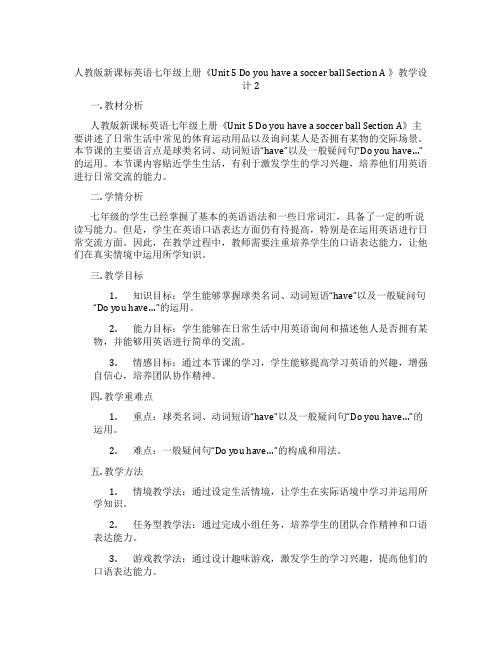
人教版新课标英语七年级上册《Unit 5 Do you have a soccer ball Section A 》教学设计2一. 教材分析人教版新课标英语七年级上册《Unit 5 Do you have a soccer ball Section A》主要讲述了日常生活中常见的体育运动用品以及询问某人是否拥有某物的交际场景。
本节课的主要语言点是球类名词、动词短语“have”以及一般疑问句“Do you have…”的运用。
本节课内容贴近学生生活,有利于激发学生的学习兴趣,培养他们用英语进行日常交流的能力。
二. 学情分析七年级的学生已经掌握了基本的英语语法和一些日常词汇,具备了一定的听说读写能力。
但是,学生在英语口语表达方面仍有待提高,特别是在运用英语进行日常交流方面。
因此,在教学过程中,教师需要注重培养学生的口语表达能力,让他们在真实情境中运用所学知识。
三. 教学目标1.知识目标:学生能够掌握球类名词、动词短语“have”以及一般疑问句“Do you have…”的运用。
2.能力目标:学生能够在日常生活中用英语询问和描述他人是否拥有某物,并能够用英语进行简单的交流。
3.情感目标:通过本节课的学习,学生能够提高学习英语的兴趣,增强自信心,培养团队协作精神。
四. 教学重难点1.重点:球类名词、动词短语“have”以及一般疑问句“Do you have…”的运用。
2.难点:一般疑问句“Do you have…”的构成和用法。
五. 教学方法1.情境教学法:通过设定生活情境,让学生在实际语境中学习并运用所学知识。
2.任务型教学法:通过完成小组任务,培养学生的团队合作精神和口语表达能力。
3.游戏教学法:通过设计趣味游戏,激发学生的学习兴趣,提高他们的口语表达能力。
六. 教学准备1.教师准备:提前准备好教学课件、球类图片、实物球类等教学资源。
2.学生准备:预习本节课内容,了解球类名词和动词短语“have”的用法。
人教版七年级英语上册《Unit 5 Do you have a soccer ball?》教学设计
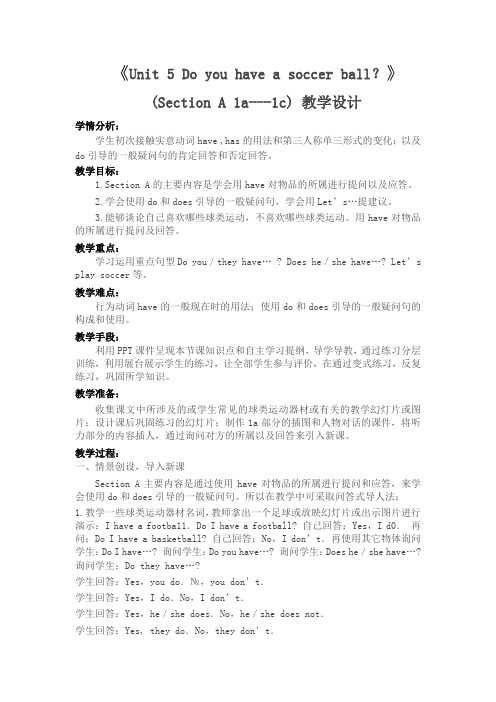
《Unit 5 Do you have a soccer ball?》(Section A 1a---1c) 教学设计学情分析:学生初次接触实意动词have ,has的用法和第三人称单三形式的变化;以及do引导的一般疑问句的肯定回答和否定回答。
教学目标:1.Section A的主要内容是学会用have对物品的所属进行提问以及应答。
2.学会使用do和does引导的一般疑问句,学会用Let’s…提建议。
3.能够谈论自己喜欢哪些球类运动,不喜欢哪些球类运动。
用have对物品的所属进行提问及回答。
教学重点:学习运用重点句型Do you/they have… ?Does he/she have…?Let’s play soccer等。
教学难点:行为动词have的一般现在时的用法;使用do和does引导的一般疑问句的构成和使用。
教学手段:利用PPT课件呈现本节课知识点和自主学习提纲,导学导教,通过练习分层训练,利用展台展示学生的练习,让全部学生参与评价,在通过变式练习,反复练习,巩固所学知识。
教学准备:收集课文中所涉及的或学生常见的球类运动器材或有关的教学幻灯片或图片;设计课后巩固练习的幻灯片;制作1a部分的插图和人物对话的课件,将听力部分的内容插人,通过询问对方的所属以及回答来引入新课。
教学过程:一、情景创设,导入新课Section A主要内容是通过使用have对物品的所属进行提问和应答,来学会使用do和does引导的一般疑问句。
所以在教学中可采取问答式导人法:1.教学一些球类运动器材名词,教师拿出一个足球或放映幻灯片或出示图片进行演示:I have a footba11.Do I have a football? 自己回答:Yes,I d0.再问:Do I have a basketball? 自己回答:No,I don’t.再使用其它物体询问学生:Do I have…? 询问学生:Do you have…? 询问学生:Does he/she have…? 询问学生:Do they have…?学生回答:Yes,you do.№,you don’t.学生回答:Yes,I do.No,I don’t.学生回答:Yes,he/she does.No,he/she does not.学生回答:Yes, they do.No,they don’t.学生进行Pair work对话练习,运用所学知识进行互动交流。
人教版英语七年级上册Unit 5 Do you have a soccer ball教学设计

人教版英语七年级上册Unit 5 Do you have a soccer ball教学设计一. 教材分析人教版英语七年级上册Unit 5主要围绕着球类运动展开,本节课将学习到关于足球的词汇和句型。
教材通过介绍不同球类运动,引导学生运用英语进行交流,提高他们的语言运用能力。
本节课的主要内容包括词汇:soccer ball, basketball, volleyball, table tennis等,以及句型:Do you have a …? Yes, I do. No, I don’t. How many … do you have?二. 学情分析七年级的学生已经掌握了基本的英语语法和词汇,具备一定的听说读写能力。
他们在日常生活中对球类运动有浓厚的兴趣,因此本节课的主题能够激发他们的学习兴趣。
然而,部分学生可能在英语表达上还存在一定的困难,需要教师在课堂上给予更多的关注和引导。
三. 教学目标1.知识目标:学生能够掌握关于球类运动的词汇和句型,正确运用Doyou have a …? 和How many … do you have? 进行交流。
2.能力目标:学生能够在小组活动中用英语介绍自己的球类运动用品,提高他们的语言运用能力。
3.情感目标:培养学生对球类运动的热爱,增强他们的团队协作精神。
四. 教学重难点1.重点:学生能够掌握关于球类运动的词汇和句型。
2.难点:学生能够正确运用Do you have a …? 和How many … do youhave? 进行交流。
五. 教学方法1.任务型教学法:通过设置不同的任务,让学生在实践中运用英语,提高他们的语言能力。
2.合作学习法:通过小组活动,培养学生的团队协作精神,激发他们的学习兴趣。
3.游戏教学法:通过球类游戏,让学生在轻松愉快的氛围中学习英语。
六. 教学准备1.教师准备:提前准备球类运动的图片、词汇卡片、录音机等教学用具。
2.学生准备:带上课本、笔记本,提前预习本节课的内容。
七年级英语上Unit 5 Do you have a soccer ball教案人教版
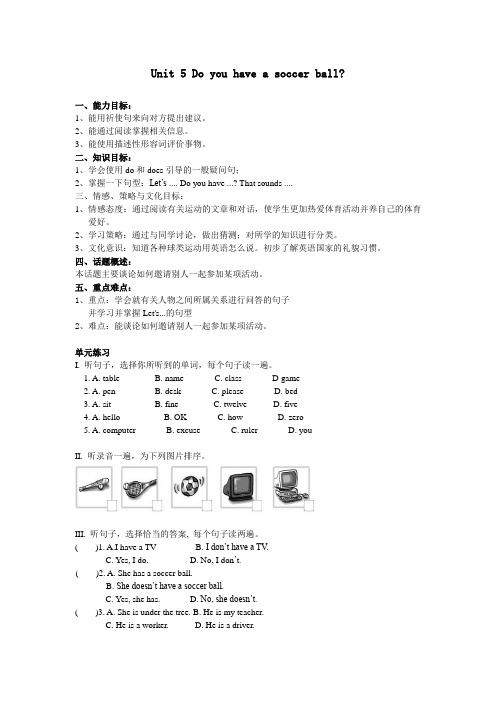
Unit 5 Do you have a soccer ball?一、能力目标:1、能用祈使句来向对方提出建议。
2、能通过阅读掌握相关信息。
3、能使用描述性形容词评价事物。
二、知识目标:1、学会使用do和does引导的一般疑问句;2、掌握一下句型:Let’s .... Do you have ...? That sounds ....三、情感、策略与文化目标:1、情感态度:通过阅读有关运动的文章和对话,使学生更加热爱体育活动并养自己的体育爱好。
2、学习策略:通过与同学讨论,做出猜测;对所学的知识进行分类。
3、文化意识:知道各种球类运动用英语怎么说。
初步了解英语国家的礼貌习惯。
四、话题概述:本话题主要谈论如何邀请别人一起参加某项活动。
五、重点难点:1、重点:学会就有关人物之间所属关系进行问答的句子并学习并掌握Let's...的句型2、难点:能谈论如何邀请别人一起参加某项活动。
单元练习I. 听句子,选择你所听到的单词,每个句子读一遍。
1. A. table B. name C. class D game2. A. pen B. desk C. please D. bed3. A. sit B. fine C. twelve D. five4. A. hello B. OK C. how D. zero5. A. computer B. excuse C. ruler D. youII. 听录音一遍,为下列图片排序。
III. 听句子,选择恰当的答案, 每个句子读两遍。
( )1. A.I have a TV B. I don’t have a TV.C. Yes, I do.D. No, I don’t.( )2. A. She has a soccer ball.B. She doesn’t have a soccer ball.C. Yes, she has.D. No, she doesn’t.( )3. A. She is under the tree. B. He is my teacher.C. He is a worker.D. He is a driver.( )4. A.I have a basketball. B. It is behind the door.C. Yes, it is my basketball.D. Yes, it is.( )5. A. That sounds good. B. Let’s play it.C. Do you play soccer?D. I have a basketball.IV. 听对话及对话后的问题,选择最佳答案将其序号填入题前括号内,每个对话读两遍。
人教版七年级英语上Unit5DoyouhaveasoccerballSectionA1a2d教学设计

8.关注情感态度:在教学过程中,教师要关注学生的情感需求,营造轻松愉快的学习氛围。对于不敢开口的学生,教师要给予鼓励和支持,帮助他们树立自信心,勇于表达。
3.教学内容:教师强调本节课的重点和难点,提醒学生注意发音和语法问题。
4.教学目标:通过总结归纳,帮助学生巩固所学知识,提高他们的英语水平。
在教学过程中,教师应关注学生的个体差异,给予每个学生充分的关注和指导,确保他们在课堂上学有所得。同时,注重培养学生的学习兴趣和自主学习能力,为他们的终身学习奠定基础。
4.情感态度:学生对英语学习兴趣浓厚,但部分学生可能因为性格内向、自信心不足等原因,不敢开口表达。因此,在教学过程中,要关注学生的情感需求,创造轻松、愉快的学习氛围,帮助他们树立自信心。
5.学习方法:学生已经具备了一定的合作学习和探究学习能力,但仍有待提高。在本节课的教学中,应继续引导学生运用小组合作、角色扮演等方法,提高他们的英语综合运用能力。
三、教学重难点和教学设想
(一)教学重难点
1.重点:本节课的重点在于掌握核心词汇和句型,如soccer, basketball, ping-pong, volleyball, tennis, play, have以及一般疑问句“Do you have...?”和回答“Yes, I do./ No, I don't.”。此外,还需关注学生在实际语境中运用这些词汇和句型进行交流的能力。
3.教学内容:练习题涉及本节课的核心词汇和句型,以及一般疑问句的构成和回答。
4.教学目标:通过课堂练习,提高学生对词汇和句型的掌握程度,培养他们的英语综合运用能力。
Do;you;have;a;soccer;ball教案

一、教学目标
1. 让学生能够用英语询问和回答是否拥有足球。
2. 让学生能够听懂、说唱英语儿歌关于足球的部分。
3. 培养学生的团队合作精神和对足球运动的兴趣。
二、教学内容
1. 单词:soccer ball, have, yes, no
2. 句型:Do you have a soccer ball? Yes, I do. No, I don't.
2. 注重团队合作,培养学生的协作精神和团队意识。
3. 教师应具备一定的足球知识,以便在游戏中给予学生指导。
4. 定期组织足球比赛,让学生在实战中提高球技。
十、课程表
1. 课程名称:Do You Have a Soccer Ball?
2. 课时:15分钟
3. 上课日期:2024年2月24日
4. 上课地点:教室
2.2 学生跟读单词和句型,教师纠正发音。
3. 课堂活动(10分钟)
3.1 学生分成小组,进行角色扮演,用英语询问和回答是否拥有足球。
3.2 教师巡回指导,纠正学生的语言错误。
4. 游戏时间(10分钟)
4.1 教师组织学生进行足球比赛,让学生在游戏中运用所学英语。
4.2 学生分组进行比赛,教师担任裁判。
5. 教学内容:复习单词和句型,进行角色扮演和足球游戏。
6. 教学目标:让学生在实际操作中运用所学英语,提高口语表达能力。
十一、教学评价
1. 观察学生在课堂上的表现,包括参与度、口语表达和团队合作能力。
2. 评估学生在角色扮演和足球比赛中的语言运用和球技表现。
3. 收集并评估学据学生的反馈和表现,调整教学方法和难度,以更好地满足学生的学习需求。
人教版英语七年级上册Unit5Doyouhaveasoccerball?(第一课时)教学设计

3.观看体育赛事:鼓励学生观看一场球类运动比赛,如足球、篮球等,了解比赛规则和赛事背景,下节课与同学分享观赛感受。
4.制作单词卡片:学生制作本节课所学词汇的单词卡片,包括单词、音标、词性和例句,以便于课余时间复习。
5.培养学生的团队精神,使学生懂得在集体中协作、共同完成任务的重要性。
二、学情分析
针对人教版英语七年级上册Unit5 “Do you have a soccer ball?”的教学内容,我们对学生的学情进行分析。七年级的学生正处于青春期,他们好奇心强,求知欲旺盛,对新鲜事物充满兴趣。在英语学习方面,他们已经具备了一定的词汇量和基本的语法知识,但口语表达能力尚需提高,尤其在实际场景中运用英语进行交流的能力。
8.教学资源利用:充分利用教材、网络资源、实物等教学工具,丰富教学内容,提高教学效果。
四、教学内容与过程
(一)导入新课
1.热身活动:教师播放一段关于不同球类运动的视频,引导学生关注各种运动项目,激发学生对本节课主题的兴趣。
2.老师提问:在观看视频后,教师提出以下问题:“Do you like sports? What sports do you like?”,让学生进行简单的口语练习,引入本节课的核心词汇和句型。
作业布置要求:
1.作业内容要与课堂教学紧密结合,注重培养学生的实际运用能力。
2.作业量适中,避免过多增加学生负担,确保学生有足够的时间进行复习和拓展。
3.鼓励学生主动完成作业,养成良好的学习习惯。
4.教师应认真批改作业,及时给予反馈,关注学生的个体差异,提高教学效果。
3.图片展示:教师展示与球类运动相关的图片,如“soccer”, “ping-pong”, “basketball”, “baseball”, “volleyball”等,让学生识别并说出相应的英文单词,为新课的学习做好铺垫。
人教版七年级英语上册教案Unit 5Do you have a soccer ball
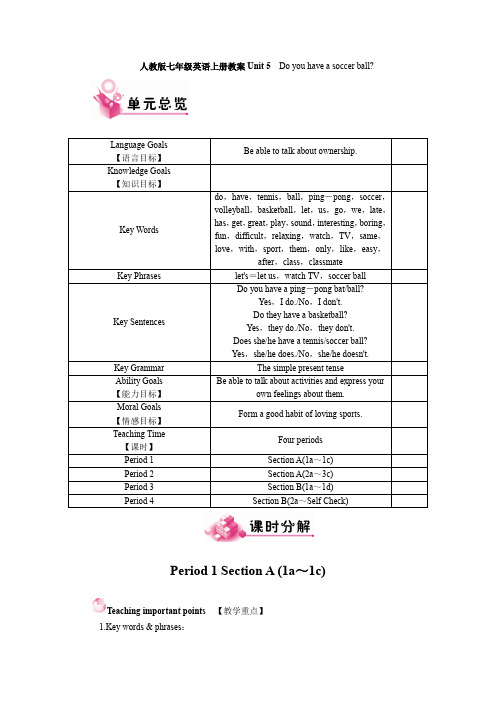
人教版七年级英语上册教案Unit 5Do you have a soccer ball?Period 1 Section A (1a~1c)Teaching important points【教学重点】1.Key words & phrases:do,have,tennis,ball,ping-pong,bat,soccer,soccer ball,volleyball,basketball2.Key sentences:Do you have a ping-pong bat?Yes,I do.Do you have a ping-pong ball?No,I don't.Teaching difficult points【教学难点】Be able to use the word “have” properly.Teaching aids【教具】CAI,pictures,a tape player,objectsTeaching procedures and ways【教学过程及方法】★Step Ⅰ Revision and lead-in复习导入Show students a ping-pong ball and ask:T:What's this?Ss:It is a ping-pong ball.T:Yes,listen,ping-pong ball(read the word three times).I have a ping-pong ball.Do you have a ping-pong ball?S1:Yes…S2:No…S3:No…T:Well,(Show students a soccer ball.) And what's this?Ss:It's a football.T:Good,it is a football.And we can also call it a soccer ball.Do you have a soccer ball?(Write down the title on the blackboard.)T:Today,let's study 人教版七年级英语上册教案Unit 5.★Step Ⅱ Self-studying and guiding自学指导Self-study 1:Self-study the new words:do,have,tennis,ball,ping-pong,bat,soccer,soccer ball,volleyball,basketball.Learn to pronounce them according to the phonetic symbols.You can listen to the tapes to help you pronounce them correctly or ask others for help.Self-study 2:Read the conversation in Part 1a and match the words with the things in the picture.Questions for thinking:(1)Do you have a computer?Yes,________ ________.No,________ ________.(2)Make up sentences with the word “have”.我每天都吃橙子。
人教版新目标版七年级英语上册Unit5Doyouhaveasoccerball教案
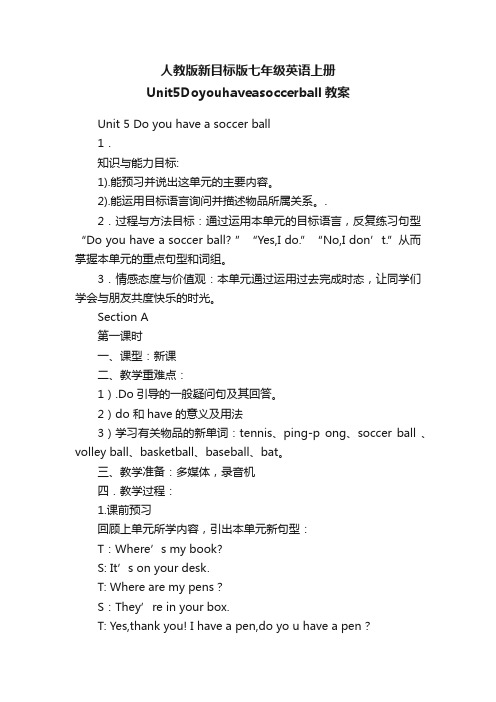
人教版新目标版七年级英语上册Unit5Doyouhaveasoccerball教案Unit 5 Do you have a soccer ball1.知识与能力目标:1).能预习并说出这单元的主要内容。
2).能运用目标语言询问并描述物品所属关系。
.2.过程与方法目标:通过运用本单元的目标语言,反复练习句型“Do you have a soccer ball? ”“Yes,I do.”“No,I don’t.”从而掌握本单元的重点句型和词组。
3.情感态度与价值观:本单元通过运用过去完成时态,让同学们学会与朋友共度快乐的时光。
Section A第一课时一、课型:新课二、教学重难点:1).Do引导的一般疑问句及其回答。
2)do 和have的意义及用法3)学习有关物品的新单词:tennis、ping-p ong、soccer ball 、volley ball、basketball、baseball、bat。
三、教学准备:多媒体,录音机四.教学过程:1.课前预习回顾上单元所学内容,引出本单元新句型:T:Where’s my book?S: It’s on your desk.T: Where are my pens?S:They’re in your box.T: Yes,thank you! I have a pen,do yo u have a pen?S:Yes,I do./No,I don’t.2.正课教授(1)引入①观察25页图片,引入新单词的学习。
②学习do引导的一般疑问句及其肯定回答和否定回答。
have的用法:①have为实义动词,意为“有”,常用句型sb.have/has+sth.表示某人有某物。
当主语为第三人称单数时,have用其第三人称单数形式。
②have还有“吃、喝”的意思,如:have breakfast。
③含有have的句子变否定句要在have前加don’t;含有has的句子变否定句要在h as前加doesn’t,has变为have。
人教版七年级英语上册第五单元unit5doyouhaveasoccerball全英教案

人教版七年级英语上册第五单元Unit 5 Do you have a soccer ball全英文教案Period One(1a-2d)Teachingaims 1) Enable students to use “have”and “has”to talk about ownership. 2) Learn the general questions begin with “do,does”and understand the personal forms and numeros.Key points1) Read and write new letters . 2) The general questions beginwith “do,does.”Difficult points 1) Learn “does” general questions and its answers.2) The usage of “has”.Languagepoints Tennis ball,ping-pong bat,soccer ball,volleyball,basketball,baseball bat.---Do you have a baseball? Yes, I do./No, I don’t.---Does she/he have a tennis ball? Yes,she does./No,she doesn’t. Ability Learn to talk about the ownership.Teaching procedures:Step 1 Warming-up1. Greetings.2. Review the letters and language structures the Ss have learnedin Unit Four.Step 2 Presentation1. Show the students other objects. Teach the new words “soccerin theball, ping-pong ball, volleyball, tennis bat, ping-pong bat” same way. --- What’s this/ tha t?---It’s …2. Look at the words in 1a and match the words with the things inthe picture.3. Present the key structure.Present these questions and answers.(Point to a student who has a pencil box.)T: Do you have a pencil box?S1: Yes, I do. (Nod your head yes) / No, I don’t. (Shake your headno)T: (Ask S2) Does she have a pencil box?S2: (Help S2 answer) Yes, she does. / No, she doesn't.Step 3 PracticeGet Ss to finish 1a.1b,1c,2a,2b,2c.Step 4 Presentation(Show a soccer ball to class.)T: Let’s play soccer ball after class, OK?S1: OK.T: We often use the drill “Let’s…”to make a suggestion. If youwant to do it, you may say “OK. / That sounds good. / All right …”If you don’t want to do it, you may say “No, I don’t have a …”Step 5 Role-play1. Cindy and Helen want to play baseball. Now read the conversation and match the things with their right places.2. Read the conversation after the teacher and practice the conversation with your partner.3. Ask some pairs to act out the dialogue in front of the class.Homework1. Recite the new words and conversations we have learned.2. Finish Exercise 1.BriefsummaryUnit5 Do you have a soccer ball?Period Two(3a-3c)Teachingaims 1) Get Ss to use have and has to talk about ownership freely. 2) Further learn the general questions begin with “do,does”andunderstand the personal forms and numeros.Key points1) The general questions begin with “do,does.” 2)The usage ofpersonal forms and numeros.Difficult points 1) How to enable students to understand ang grasp the usage of personal forms and numeros.Languagepoints Great, play, That sounds good.---Does Bob have a soccer ball? Yes,he does./No,he doesn’t.Ability understand and grasp the usage of personal forms and numeros skilfully.Teaching procedure:Step 1 Warming-up1.Greeting the Ss. Check their homework. (Let some Ss reporttheir parents' sports collection)2. Let the Ss work in groups (each group has three Ss). Reviewthe sentence structures we learned.Step 2. Grammar Focus.Get Ss to read the sentences in the chart and drawa conclusion about how to use “do” and “does.”Step 3 Practice1. 3a. Write each word in the correct place in the chart.2. 3b. Ss complete the conversations with their partner.3. Check the answers with the class. (Let some pairs readthe conversation).4. Ss practice the conversation with their partner then act outthe dialogue.Step 4 Game (Remembering game)T: Look! This is Bob's room. He has many things. Look at thethings in his room for three minutes. Then close your booksand ask and answer questions with your partner.Step 5 Homework1. Recite the new words and conversations we have learned.2. Finish Exercise 2.BriefsummaryUnit5 Do you have a soccer ball?Period Three(Section B 1a-2c )Teachingaims 1)Get Ss to grasp the new words andphrases:interesting,fun,relaxing,boring,difficult.2)Get Ss to understand the survey results:Who has a soccer ball?Key points1) Talk about Ss’ likes and dislikes with description words.2)GetSs to find the answer to the questions after they read the essay.Difficult points How to enable students to understand and grasp the new words and phrases.Languagepoints Interesting, difficult, easy,relaxing,boring,fun,love sports,after class,watch TV.---Let’s play……----That sounds…..Ability Develop Ss’ primary reading abilities.Enable them to find the answer to the questions.Teaching procedure:Step 1 Warming-up1. Greet the Ss. Check the homework. (Let some pairs read out their conversation. Correct the mistakes they make)2. Review the chart of pronouns. (Show the chart on the screen)3. Let Ss look at the picture in 3a. Ask some pairs ask and answer about the picture.Step 2. Presentation1. (Show the picture which a boy is doing an interesting thing on the screen.) Learn the new words, interesting2.(Show other pictures on the screen) learn the new words: boring, fun, difficult, relaxing, easy, in the same way3. (Show some activity pictures on the screen) Learn the new phrases: "watch TV", "go to the same school", "love soccer", "after class" and "play sports"4. (Show some pictures of students on the screen)Learn the new words "student", "classmate"5. Let Ss read the new words and phrases and try to remember them.6. Read the words in 1a. (Point to the five words in 1a and ask students to repeat each one.)Correct the answers.Step 3 Listening1. Next we’ll listen to a conversation. Here are two boys in the conversation. What do they want to do? Listen.(Play the recording the first time.) (For the first time, students only listen.)2. Listen again and check the words you hear in 1a. (Play the recording again.), after that, get Ss to finish 1c.3. Check the answers.Step 4 Pair work1. T: Act out the conversation in 1c in pairs. You are Paul. Your partner is Paul's friend, Jenny. Talk about the activities in 1c.2. Let some pairs act out the conversation in front of the class. Step 5 Presentation1. (T holds basketball and another student holds a soccer ball)T: I have a basketball, but I don't have a soccer ball.He has a soccer ball, but he doesn't have a basketball.2. Write the sentence structure on the blackboard.形为动词have的否定句的构成:①第一人称/第二人称/第三人称复数人称+ don't + have + 某物②第三人称单数形式+ doesn't + have + 某物e.g.I don't have a watch.She doesn't have a tennis ball.Step6 Writing1. Find the sports words in the unit. Write them in the correct column.2. Make a report to your partner first.S1: I have a soccer ball, a volleyball, two tennis balls, three ping-pong bat…I don't have a basketball, a tennis bat, a baseball bat…3. Exchange the chart with your partner. Report your partner's sports collection.S2: He has a soccer ball, a volleyball, two tennis balls, three ping-pong bats…He doesn't have a basketball, a tennis bat, a baseball bat…Step7 Reading1. Our school magazine made a survey about sports collection. This is the survey result. Read the passage a nd answer the question:Who has a soccer ball?2. Ss read the passage q uickly and find the answer to thequestion.3. Check the answer. Let some students say their answer andsay why?4. Now let's work on 2c.Who do you think says these sentences? C heck (√) F forFrank, G for Gina or W for Wang Wei.Homework1. Review the new words we learn in this part.2. Finish Exercise3.BriefsummaryUnit5 Do you have a soccer ball?Period Four(Section B 3a-self check )Teachingaims 1)Go on learning the general questions beginning with Do or Does and the answers.2)Go on learning don’t or doesn’t in the negative sentences,understand the usage of but.Key points1)Consolidate the usage of have in the negative and generalquestions.2)Develop Ss’ abilities of writing.Difficult points Guide Ss to write with have in the negative and general questions.Languagepoints Does your mom have a baseball bat? Tom has a baseball, but he doesn’t have a baseball bat.Ability Get Ss to use have or has to write a short passage in the real situation. Teaching procedure:Step 1 Warming-up1. Greet the Ss. Check the homework. (show the chart on thescreen.)2. Review the sports words in the unit. Then let some Ss reportthe sports things they have and the things they don't have.Step 2. Writing1. Let's work on 3a. This is a survey chart. You have to writesome more questions about sports equipment in the chart. Usingthe sentence structure "Do you have a…?".2. Ss write three or more questions about sports equipment.Step 3 SurveyNow exchange books with your partner. Answer his or herquestions in 3a.You can only check (√) of the answers.Step 4 Writing1. Look at the information in 3a. Write about yourself and yourpartner with but.Ss read the first two sentences a nd try to write their own sentences according to 3a.2. 指导:①but是一个转折连词,表示意思上的转折,常用来连接两个句子。
人教版英语七年级上册Unit5Doyouhaveasoccerball说课稿

人教版英语七年级上册Unit 5 Do you have a soccer ball说课稿一. 教材分析人教版英语七年级上册Unit 5 Do you have a soccer ball是一篇以询问和描述物品为主题的课文。
本节课的主要内容是让学生掌握一般现在时态的疑问句和回答,以及学会使用have作为实义动词的用法。
通过对课文的学习,学生能够提高自己的听说能力和交际能力。
二. 学情分析针对七年级的学生,他们对英语已经有了一定的了解和掌握,但仍有部分学生对英语学习存在恐惧心理,学习积极性不高。
针对这一情况,教师需要在教学过程中注重激发学生的学习兴趣,提高他们的学习积极性。
此外,学生在本节课需要掌握一般现在时态的疑问句和回答,以及实义动词have的用法,这对他们来说是一个新的知识点,需要在教学中进行重点讲解和练习。
三. 说教学目标1.知识目标:学生能够掌握一般现在时态的疑问句和回答,以及实义动词have的用法。
2.能力目标:学生能够听懂、会说本节课的主要句型,提高自己的听说能力。
3.情感目标:通过本节课的学习,学生能够激发对英语学习的兴趣,提高自己的学习积极性。
四. 说教学重难点1.重点:一般现在时态的疑问句和回答,实义动词have的用法。
2.难点:一般现在时态的疑问句和回答的运用,实义动词have在不同语境中的用法。
五. 说教学方法与手段1.采用情境教学法,通过设定生活情境,让学生在实际语境中学习英语。
2.运用任务型教学法,让学生在完成任务的过程中,巩固所学知识。
3.采用分组合作学习,提高学生的团队协作能力和交际能力。
4.利用多媒体教学手段,如PPT、视频等,丰富教学内容,提高学生的学习兴趣。
六. 说教学过程1.导入:通过问答方式,引导学生复习一般现在时态的肯定句和否定句。
2.新课呈现:展示课文图片,引导学生回答问题,引入本节课的主题。
3.课堂讲解:讲解一般现在时态的疑问句和回答,以及实义动词have的用法。
人教版七年级英语上册Unit5Doyouhaveasoccerball教学设计
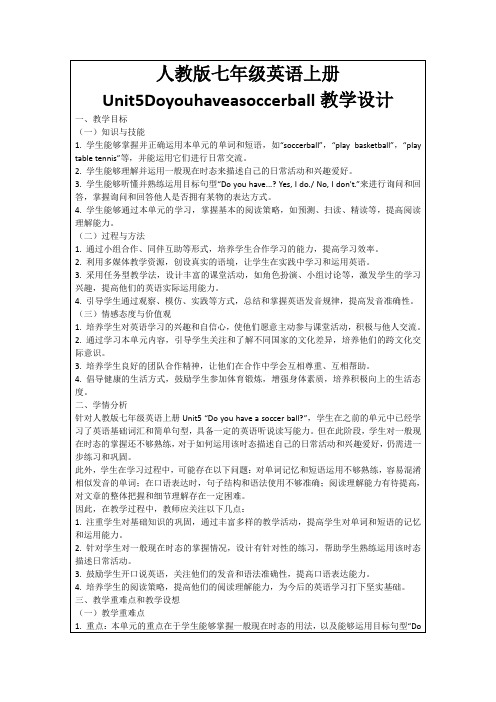
因此,在教学过程中,教师应关注以下几点:
1.注重学生对基础知识的巩固,通过丰富多样的教学活动,提高学生对单词和短语的记忆和运用能力。
2.邀请几名学生分享他们在课堂上的收获和感悟,鼓励他们用英语进行表达。
3.教师布置课后作业,要求学生运用本节课所学的知识,写一篇关于自己喜欢运动的小短文,巩固所学内容。
五、作业布置
为了巩固本节课的学习内容,确保学生对一般现在时态和运动类词汇的掌握,特布置以下作业:
1.请每位学生撰写一篇关于自己最喜爱的运动的小短文,要求使用一般现在时态描述自己参与这项运动的情况,不少于80词。短文中需包含至少5个本节课学习的运动类词汇。
2.利用多媒体展示各种运动的图片,如soccer, basketball, table tennis等,引导学生认识和复习相关运动词汇。
3.通过提问方式,如“Do you have a soccer ball?”,引入本节课的主题,为新课的学习做好铺垫。
(二)讲授新知
1.教师呈现Unit5的教材内容,引导学生学习一般现在时态的用法,并通过示例句型“Do you have...? Yes, I do./ No, I don't.”进行讲解和示范。
2.学生与家长进行一次英语对话,用一般现在时态询问家长是否拥有某项运动器材,如:“Do you have a basketball?”,并记录下对话内容。
3.完成课后练习册中与本单元相关的练习题,重点加强对一般现在时态的掌握。
4.鼓励学生利用课余时间,与同学进行运动类词汇的接龙游戏,提高词汇记忆能力。
人教版英语七年级上册Unit 5 Do you have a soccer ball教案
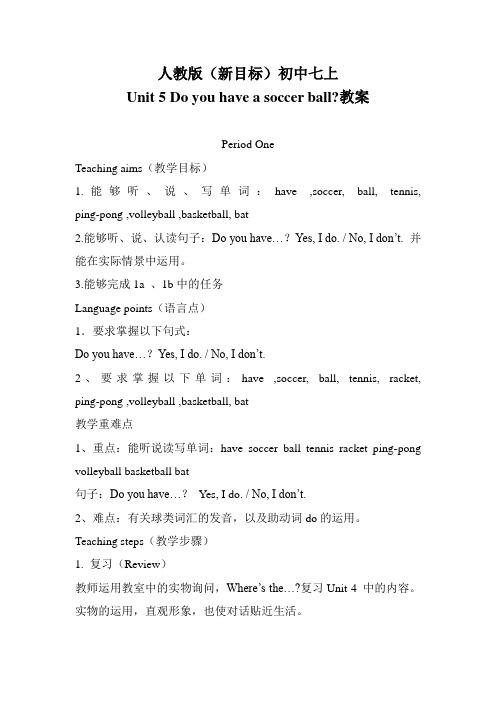
人教版(新目标)初中七上Unit 5 Do you have a soccer ball?教案Period OneTeaching aims(教学目标)1.能够听、说、写单词:have ,soccer, ball, tennis, ping-pong ,volleyball ,basketball, bat2.能够听、说、认读句子:Do you have…?Yes, I do. / No, I don’t. 并能在实际情景中运用。
3.能够完成1a 、1b中的任务Language points(语言点)1.要求掌握以下句式:Do you have…?Yes, I do. / No, I don’t.2、要求掌握以下单词:have ,soccer, ball, tennis, racket, ping-pong ,volleyball ,basketball, bat教学重难点1、重点:能听说读写单词:have soccer ball tennis racket ping-pong volleyball basketball bat句子:Do you have…?Yes, I do. / No, I don’t.2、难点:有关球类词汇的发音,以及助动词do的运用。
Teaching steps(教学步骤)1. 复习(Review)教师运用教室中的实物询问,Where’s the…?复习Unit 4 中的内容。
实物的运用,直观形象,也使对话贴近生活。
2. Presentation(呈现新知识)出示踢足球的幻灯片,引出新单元主题:T:What’s this in English?Ss:It’s a ball.T:What ball is it?S1:It’s a soc cer ball.出示basketball的图片,呈现新单词:T:What’s this in English?Ss:It’s a basketball,书写并拼读basketball.以同样的方法教学soccer, ball, volleyball, tennis, tennis racket ,bat,ping-pong, 朗读单词并记忆图片,可采用集体读,小组或个别读的形式.。
人教版七年级英语上册Unit 5 Do you have a soccer ball教案
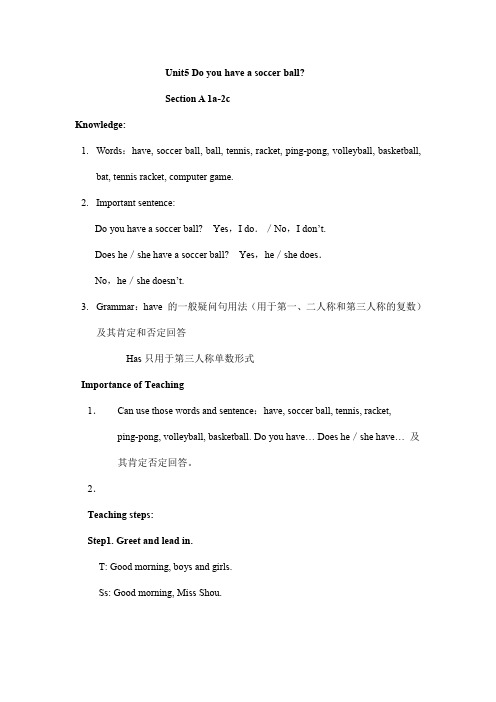
Unit5 Do you have a soccer ball?Section A 1a-2cKnowledge:1.Words:have, soccer ball, ball, tennis, racket, ping-pong, volleyball, basketball,bat, tennis racket, computer game.2.Important sentence:Do you have a soccer ball?Yes,I do./No,I don’t.Does he/she have a soccer ball?Yes,he/she does.No,he/she doesn’t.3.Grammar:have 的一般疑问句用法(用于第一、二人称和第三人称的复数)及其肯定和否定回答Has只用于第三人称单数形式Importance of Teaching1.Can use those words and sentence:have, soccer ball, tennis, racket, ping-pong, volleyball, basketball. Do you have… Does he/she have… 及其肯定否定回答。
2.Teaching steps:Step1. Greet and lead in.T: Good morning, boys and girls.Ss: Good morning, Miss Shou.T: Each week we have two PE lessons. Do you know the Chinese meaning of PE?Ss: 体育T:Yes,very good. Do you like PE?Ss: Yes.T: In PE lessons, we will play some ball games. Can you list any of them?Ss: Basketball, baseball, handball, ping-pong ball, tennis, volleyball, badminton (羽毛球).(让学生先举例,熟悉这些球类物品)Step2. Show the balls.Step3. Do exercise. SectinA1a ( P25) Match the words with the things in the picture.Now we have known these sports goods, and let’s do some exercise to remember them.Keys: 1. c 2. a 3. e 4. f 5. d 6. b(通过练习,学生们进一步掌握关于球类物品的新单词)Step 4 Ask and answer.T: What is this in English?S A: It is a pen.T: Is it your pen?S A: Yes, it is.T: Do you have a pen?S A: Yes, I do.Step 5 Pair workLook at the picture. Let the students ask and answer each other: Do you have a baseball? Yes, I do. No, I don’t.(通过实际操练,掌握句型)Step 6 Listen to 1b, circle the words you hear.Step7 Pair workT: Now I will introduce these two boys to you. This is Jim, and this is Tom. Now does Tom have a ping-pong ball?Ss: Yes, he does.T: Does Tom have a ping-pong bat?Ss: No, he doesn’t.Three students a group, then practice this conversation.For example:S A asks S B: Do you have a baseball?S B: Yes, I do.S A asks S C: Does she have a baseball?S B: Yes, she does.(通过此次对话,让学生们掌握这节课的两个重要句型)Step 6 Listen to 2a, listen to the conversations and number the pictures.Listen again. Match the people with the balls.Step7 ReviewNow please close your English book and your eyes. Let’s review what we have learned in this class.Step8 Rewrite the composition “My bedroom”This is my bedroom. It’s very nice. I have a bed. I t is near the wall. I have a dresser. It is beside the bed. I have…………………… I love it very much.。
人教版七年级英语上册第五单元Doyouhaveasoccerball教案设计
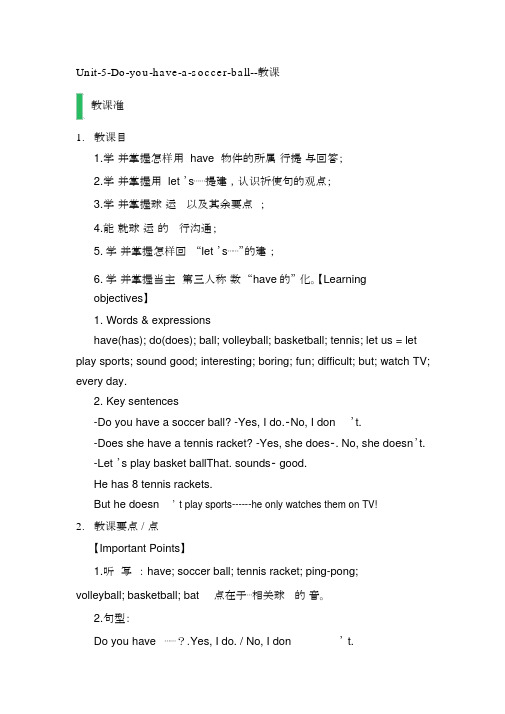
Unit-5-Do-you-have-a-soccer-ball--教课教课准1.教课目1.学并掌握怎样用 have 物件的所属行提与回答;2.学并掌握用 let ’s⋯⋯提建,认识祈使句的观点;3.学并掌握球运以及其余要点;4.能就球运的行沟通;5.学并掌握怎样回“let ’s⋯⋯”的建;6.学并掌握当主第三人称数“have的” 化。
【Learningobjectives】1. Words & expressionshave(has); do(does); ball; volleyball; basketball; tennis; let us = let play sports; sound good; interesting; boring; fun; difficult; but; watch TV; every day.2. Key sentences-Do you have a soccer ball? -Yes, I do.–No, I don’t.-Does she have a tennis racket? -Yes, she does–. No, she doesn’t.-Let ’s play basket ballThat. sounds– good.He has 8 tennis rackets.But he doesn’ t play sports------he only watches them on TV!2.教课要点 /点【Important Points】1.听写: have; soccer ball; tennis racket; ping-pong;volleyball; basketball; bat点在于⋯相关球的音。
2.句型:Do you have⋯⋯?.Yes, I do. / No, I don’ t.Does she have⋯⋯? Yes, she does. / No, she doesn’ t.点在于助do 的运用。
人教版七年级英语上册Unit5Doyouhaveasoccerball?(5课时教案)
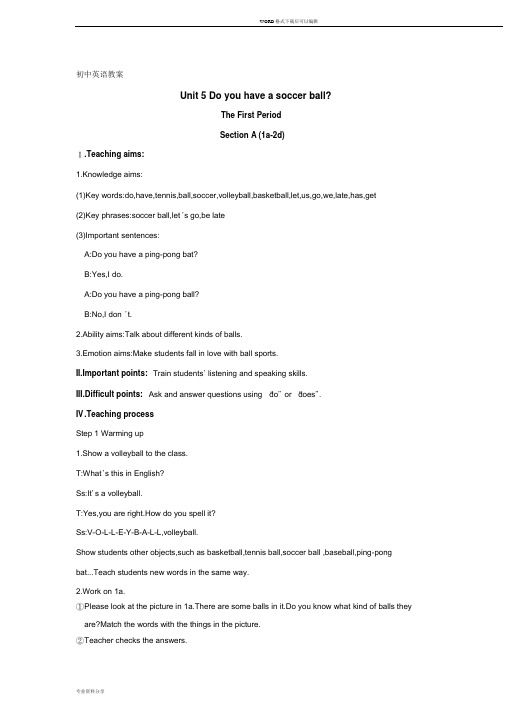
初中英语教案Unit 5 Do you have a soccer ball?The First PeriodSection A (1a-2d)Ⅰ.Teaching aims:1.Knowledge aims:(1)Key words:do,have,tennis,ball,soccer,volleyball,basketball,let,us,go,we,late,has,get(2)Key phrases:soccer ball,let ’s go,be late(3)Important sentences:A:Do you have a ping-pong bat?B:Yes,I do.A:Do you have a ping-pong ball?B:No,I don ’t.2.Ability aims:Talk about different kinds of balls.3.Emotion aims:Make students fall in love with ball sports.II.Important points: Train students’listening and speaking skills.III.Difficult points: Ask and answer questions using “do”or “does”.IV .Teaching processStep 1 Warming up1.Show a volleyball to the class.T:What ’s this in English?Ss:It’s a volleyball.T:Yes,you are right.How do you spell it?Ss:V-O-L-L-E-Y-B-A-L-L,volleyball.Show students other objects,such as basketball,tennis ball,soccer ball ,baseball,ping-pong bat...Teach students new words in the same way.2.Work on 1a.①Please look at the picture in 1a.There are some balls in it.Do you know what kind of balls they are?Match the words with the things in the picture.②Teacher checks the answers.③Look at the key structure.—Do you have a ping-pong bat?—Yes,I do.—Do you have a ping-pong ball?—No,I don ’t.Read the words and dialogue after the teacher and then read it together.Step 2 ListeningWork on 1b,2a,2b.4.Play the recording for the first time.Students only listen.5.Play the recording again and ask students to do 1b,2a,2b.6.Check the answers in 1b,2a,2b.Step 3 PairworkWork on 1c.Practice the conversation with your partner. Then ask and answer questions about the things in 1a. A: Do you have a ping-pong bat?B: Yes,I do.A: Do you have a ping-pong ball?B: No, I don ’t.Work on 2c.Ask and answer questions about the people in 2a.A:Does Jane have a tennis ball?B:No,she doesn’t.Ask some pairs to act out their conversation.Step 4 Role-playWork on 2d.Let students read the conversation after the teacher,and then practice the conversation with their partners.Teacher asks some pairs to act out the conversation in front of the class.Language points3.have的用法(1)have 为实义动词,意为“有”,常用句型为sb. have/has +sth.,表示“某人有某物”,当主语为第三人称单数时,have用其单三形式has。
- 1、下载文档前请自行甄别文档内容的完整性,平台不提供额外的编辑、内容补充、找答案等附加服务。
- 2、"仅部分预览"的文档,不可在线预览部分如存在完整性等问题,可反馈申请退款(可完整预览的文档不适用该条件!)。
- 3、如文档侵犯您的权益,请联系客服反馈,我们会尽快为您处理(人工客服工作时间:9:00-18:30)。
Unit 5 How old is he?
Lesson 17
Task: To learn to identify people
Language points: Who is this/that? This/That/It is…. How old is he/she/it? He/She/It is…. Difficult points: Using he, she and it
Teaching steps:
Step 1 Revision
1.Revise: What’s your name? Can you spell it, please? How old are you?
2.Revise the numbers 0-20. Teach 21.
Step 2 Prevision checking
Read the phonetic scripts and match them with the relevant words
Step 3 Presentation
Show the pictures of Yao Ming, Liu Xiang, Guo Jingjing, Cai Yilin and Polly and present
Who is this? This is …. How old is he/she/it? He/She/It is ….I don’t know. I think ….
Step 4 Drill
Get the class to ask and answer about the pictures as follows:
Girls: Who is this?
Boys: This is….
Girls: How old is he/she?
Boys: He/She is ….
Step 5 Read, ask and answer (Part 1)
Get the Ss to ask and answer in pairs.
Step 6 Practice
Fill in the blanks with its or it’s
Step 7 Ask and answer (Part 2)
Books closed. Ask the Ss to look at the wall chart. Play the tape once. Then play it again and get the class to repeat.
Step 8 Pair practice
Get the Ss to read the dialogues in pairs. They can continue practicing using the pictures or pointing to their classmates.
Step 9 Workbook
Exx. 1-2.
Lesson 18
Task: To learn to identify people
Language points: What’s his/h er/its name? His/Her/Its name is …. Is he/she/it …? Yes, he/she/it is. No, he/she/it isn’t.
Difficult points: Using his, her and its
Teaching steps:
Step 1 Revision
Step 2 Look, ask and answer(Part 1)
Say: Open your books to Page 22. Look at Part 1. Point to Picture 1. Who’s that in Picture 1? That’s/He’s Mr Smith.
Get the Ss to repeat Mr Smith. Repeat with Picture 2-4.
Step 3 Drill
Get the class to ask and answer using the pictures in Part 1.
Step 4 Presentation
Show the pictures of a boy, a girl, a man and a woman. Ask questions about the four people: What’s his/her name? How old is he/she? I don’t know. I think ….
Step 5 Presentation
Show the pictures of Polly and a cat. Ask questions about them: What’s this? What’s its name? How old is it?。
